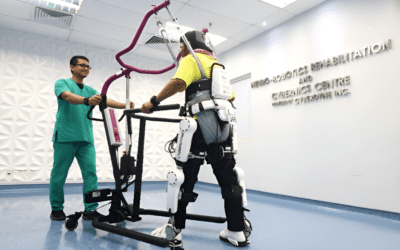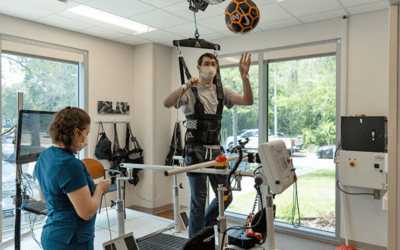Post-concussion syndrome (PCS) continues to be a challenging condition for healthcare professionals and patients alike, with symptoms that can linger long after the initial injury. PCS affects many aspects of life, from headaches, dizziness, and cognitive difficulties to emotional disturbances. However, with medical technology advancements, emerging therapies offer new hope. These technologies are reshaping neurorehabilitation, making it more precise, personalized, and effective. In this blog, we will explore the latest technological innovations that are transforming the treatment of post-concussion syndrome.

Understanding Post-Concussion Syndrome (PCS)
Before delving into those innovative technologies, taking a step back and understanding what PCS entails would be prudent. After a traumatic brain injury, such as a concussion, some people experience symptoms for weeks, months, or even years. These symptoms can be broadly categorized as:
Physical Symptoms: Headaches, dizziness, and hypersensitivity to light
Cognitive Symptoms: Loss of concentration, amnesia, and brain fogginess
Emotional Symptoms: Depression, anxiety, irritability, and mood swings
Innovative Technologies in Post-Concussion Syndrome Treatment Revolutionizing PCS Rehabilitation
Traditional treatments consist of drugs and physical therapy focused on symptom management, but are now complemented by cutting-edge technical interventions that promise better results in the fast-moving horizon of neurorehabilitation.
1. Virtual Reality (VR) Therapy
Virtual reality is one of the most exciting tools in neurorehabilitation. It will simply put patients in simulated environments; that way, they can engage in controlled cognitive and physical exercises. Virtually reality therapy has a unique edge over other types of PCS; the brain gets visual and auditory feedbacks while challenging the neural pathways to encourage recovery.
Through PCS, the rehabilitation approach can be modified through VR to advance specific cognitive functions like memory, attention, and visual-spatial. For instance, it could help alleviate the occurrence of motor symptoms such as imbalance and coordination or put the patient through real-life scenarios like crossing different terrains and kind of environments. The immersive environment makes it easier for therapists to track progress and change the levels of exercises according to the possible capabilities of the patient.
Additionally, the treatments based on VR entail emotional charges because patients can be taught mindfulness and relaxation skills within soothing virtual environments. This may aid in the alleviation of symptoms of PCS stress and anxiety for a patient.
2. Artificial Intelligence in Cognitive Rehabilitation
AI in neurorehabilitation, especially cognitive rehabilitation for patients with PCS, has great promises and AI-powered platforms that use machine learning algorithms to monitor performance in real-time and produce customized programs tailored to the patient as they continue; it also assesses memory, attention, problem-solving abilities, and executive functions and plans exercises to strengthen such skills.

For instance, cognition-related apps based on AI may provide a game of memory or puzzles and update the degree of difficulty in the performance of the patient. The real-time feedback of the AI system can help determine specific cognitive deficits, therefore tailoring interventions more precisely by therapists.
Outside the hospital or clinic walls, virtual assistants based on AI also contribute to supporting patients. Digital assistants offer patients the mental exercises they require and remind them to take their breaks. They monitor daily progress. Therefore, technology makes possible continuous care that applies rehabilitation even outside of the setting of a hospital room.
3. Brain-Computer Interfaces (BCIs) in Neurorehabilitation and Innovative Technologies in Post-Concussion Syndrome Treatment
Another revolutionizing application of technology in neurorehabilitation involves the use of brain-computer interfaces (BCIs). BCIs utilize sensors located on the scalp to monitor brain activity. The activity is thereafter interpreted into commands that activate different devices or computer programs. In PCS, BCIs may enable the restoration of several kinds of cognitive and motor functions by training the brain to engage in exercise that invites neuroplasticity.
For example, participating in a BCI system, like the one that is to be designed to provide PCS patients the ability to play cognitive or motor-based video games using only their brain activity, may serve as a therapeutic process. For most patients, these tasks will induce an active reorganizational process in their brains, creating new neural connections that could potentially restore lost or reduced functions. Such an interactive interface with the system through thought, especially in cases where impaired movement makes it difficult for individuals to perform standard cognitive tasks, has great applications.
BCIs can even monitor real-time brain activity, and then clinicians can track the pace of recovery and change treatments accordingly.
4. Exoskeleton Robots for Physical Rehabilitation
PCS can also result in physical disability with complications such as loss of balance, coordination, and mobility. The wearable device called a robotic exoskeleton can support and enhance natural body movements, which makes these devices very ideal for the rehabilitation of persons with PCS.
Robotic exoskeletons can sense the movements of the wearer using sensors and actuators that support where this is necessary. For example, when a patient with PCS cannot walk due to dizziness or imbalance, the device can offer stability as well as support to enable the patient to walk much more in control. This way enables them to walk about safely as they train their walking abilities.
These devices, in particular, are useful for patients with PCS who are undergoing vestibular rehabilitation because they can reproduce real-life scenarios, for example, walking on uneven terrain or climbing stairs. The data produced by the exoskeleton may be followed to track improvement in mobility and adjusted appropriately in the rehabilitation protocol.
5. Transcranial Direct Current Stimulation (TDCS)
Transcranial direct current stimulation represents a non-invasive method of the modulation of brain activity using low-intensity electrical currents. PCS patients demonstrated its ability to improve cognitive functions, reduce fatigue, and boost mood.
It has been applied using electrodes placed on the scalp over specific areas of the brain when tDCS is applied. That low current is then delivered to those areas, which stimulates neurons in the underlying brain tissue and induces reorganization by boosting neuroplasticity and recovery.
tDCS is particularly useful for PCS patients who have cognitive impairment-for example, loss of memory or attention deficits- because it can be applied directly over the parts of the brain involved with those functions. tDCS also reduces symptoms of anxiety and depression-another common package of emotional symptoms following PCS.
6. Telemedicine and Remote Neurorehabilitation
With the development of telemedicine, neurorehabilitation for patients suffering from PCS is even more available than ever. A remote rehabilitation platform would allow a patient to reach specialists from home without having to constantly visit hospitals or clinics.
Engage in guided exercise, track symptoms, and get immediate feedback from healthcare providers using a combination of wearable devices, mobile apps, and video consultations. Actually, telemedicine platforms benefit patients suffering from PCS because such patients might have difficulty traveling around due to dizziness or fatigue.
Moreover, telemedicine allows for real-time tracking. Through wearable technology, a patient’s level of activity, sleep patterns, and even cognitive performance can be monitored. Such results guide the therapy to be individualized in such a way that it addresses the needs of the patient in the best possible manner during recovery from PCS.
Conclusion: Conclusion: The Future of Innovative Technologies in Post-Concussion Syndrome Treatment and PCS Rehabilitation
The treatment for post-concussion syndrome is on the brink of a new age, one in which technological advances will propel care toward data-driven and personalized approaches. Ranging from virtual reality and artificial intelligence to brain-computer interfaces and robotic exoskeletons, such technologies can greatly change neurorehabilitation for patients with PCS.
As these researches continue to advance and make these technologies even more refined, we can expect far superior improvements in recovery outcomes by allowing people to regain their cognitive, emotional, as well as physical capabilities. Integrating these emerging technologies into PCS rehabilitation means a future that is hopeful and far from the debilitating effects brain injuries once represented.



